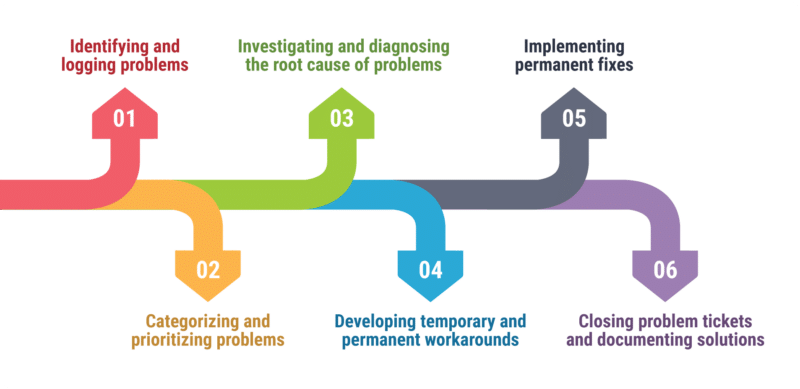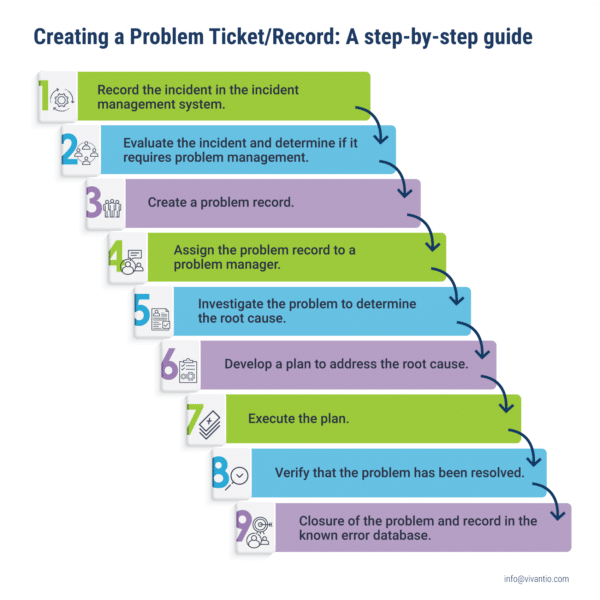Mastering Problem Ticket ITIL: Minimizing Disruptions
Introduction
Key Takeaways:
- Problem ticket ITIL is an essential tool in enhancing IT infrastructure efficiency and minimizing disruptions.
- Problem management is all about identifying the root cause of incidents and developing a plan to prevent them from happening again.
- Problem ticket ITIL helps you track and analyze incidents so you can make informed decisions about how to address them.
- Proactive problem management techniques, such as change management and workarounds, can help prevent incidents from happening in the first place.
- Implementing a problem management process can offer significant benefits in terms of restoring service and preventing future incidents.
If you’re in charge of managing IT infrastructure, you know how critical it is to minimize disruptions and ensure everything is running efficiently. That’s where problem ticket ITIL and problem management come in – these techniques can revolutionize your approach to resolving IT incidents and ensuring your systems are stable.
Problem management is all about identifying the root cause of incidents and developing a plan to prevent them from happening again. By doing this, you can minimize downtime and ensure your systems are running at peak efficiency. Problem ticket ITIL is an essential tool in this process, helping you track and analyze incidents so you can make informed decisions about how to best address them.
In this article, we’ll explore the role of problem ticket ITIL and problem management in enhancing IT infrastructure efficiency and minimizing disruptions. We’ll delve into the specifics of problem management, including its relationship to incident management and service operation. We’ll also explore proactive problem management techniques and highlight the benefits of implementing a problem management process.
Understanding Problem Ticket ITIL and Incident Management
You might be wondering, what is the relationship between incident management and problem ticket ITIL? Well, incident management is the process of managing incidents with the aim of restoring normal service operations as quickly as possible. On the other hand, problem ticket ITIL involves identifying the root cause of one or more incidents, developing a permanent fix, and implementing changes to prevent the incidents from happening again.
It’s important to note that incident and problem management are interdependent. Incident management focuses on minimizing the impact of incidents while problem management aims to prevent their recurrence. They are both critical components of service management and work hand in hand to ensure that IT services are reliable and efficient.
The problem ticket, also known as a problem record, is the cornerstone of the problem management process. It is essentially a detailed report of a problem that includes the root cause, symptoms, impact, and potential solutions. Problem tickets are used to initiate the problem management process and keep track of its progress.
The problem management process involves:

- Identifying and logging problems
- Categorizing and prioritizing problems
- Investigating and diagnosing the root cause of problems
- Developing temporary and permanent workarounds
- Implementing permanent fixes
- Closing problem tickets and documenting solutions
By following this process, organizations can minimize the impact of incidents on their IT infrastructure, reduce downtime, and prevent future incidents from occurring. It’s important to note that the problem management process is an ongoing activity that requires continuous improvement to ensure that it remains effective in addressing new challenges that may arise.
The Role of Service Management in Incident and Problem Management
Service management involves integrating people, processes, and technology to deliver quality services that meet the needs of customers. It provides a framework for managing IT services and aligning them with business objectives. Service management is crucial in incident and problem management as it ensures that the IT services are delivered efficiently and effectively.
Implementing problem management within your organization requires a sound understanding of the problem management process, the use of problem management software, and the commitment of a dedicated team. By doing so, you will be able to identify the root cause of incidents, prevent their recurrence, and ultimately provide better IT services to your customers.
The Role of Problem Management in Service Operation
When it comes to managing IT infrastructure, the service desk is often the first line of defense. While the service desk can handle many incidents, it is essential to have a problem management process in place for those incidents that require more in-depth analysis and resolution. The problem management process is responsible for identifying the root cause of problems and implementing solutions to prevent future incidents.
The first step in the problem management process is to create a problem record. This record contains all relevant information about the incident, including the date and time, the service affected, and other pertinent details. Once the problem record is created, the problem management team can begin investigating the incident.
The key to effective problem management is to identify the root cause of the incident. To do this, the problem management team will use a variety of tools and techniques, including data analysis and interviews with relevant stakeholders. Once the root cause is identified, the team can develop a plan to address the problem and prevent it from happening again.
One of the most important outputs of the problem management process is the known error database. This database contains information about all known errors and their respective workarounds. By maintaining a known error database, the problem management team can quickly resolve incidents and minimize disruptions to the IT infrastructure.
In addition to identifying and resolving incidents, the problem management process also plays a key role in proactive problem management. By analyzing incident data and identifying trends, the problem management team can anticipate and prevent future incidents from happening.
Creating a Problem
To create a problem, you need to follow a set of steps that ensure that the incident is analyzed, the root cause is identified, and the appropriate action is taken. Here’s a step-by-step guide:

- Record the incident in the incident management system.
- Evaluate the incident and determine if it requires problem management.
- Create a problem record.
- Assign the problem record to a problem manager.
- Investigate the problem to determine the root cause.
- Develop a plan to address the root cause.
- Execute the plan.
- Verify that the problem has been resolved.
Closure of the problem and record in the known error database.
By following these steps, you can ensure that incidents are effectively analyzed and resolved, and that the IT infrastructure is more resilient to future disruptions.
The Importance of the Service Desk in Problem Management
The service desk plays a critical role in problem management. It is often the first point of contact for incidents, and it is responsible for recording incidents and escalating them to the problem management team when necessary. The service desk is also responsible for communicating with end-users and keeping them informed of the status of their incidents.
Effective communication between the service desk and the problem management team is critical for successful problem management. The service desk should provide the problem management team with timely and accurate information about incidents, including any relevant logs or data. The problem management team should provide updates to the service desk on the status of investigations and resolutions.
The Role of Problem Management
The role of problem management in service operation is essential for maintaining a reliable and efficient IT infrastructure. By creating problem records, identifying root causes, and developing solutions, the problem management team can prevent future incidents and minimize disruptions. Effective communication between the service desk and the problem management team is critical for successful problem management. By following a set of steps to create and resolve problems, you can ensure effective incident management and problem resolution.
Proactive Problem Management to Minimize Incidents
In the world of IT, even a minor outage can cause significant disruptions to your organization’s day-to-day operations. That’s why it’s essential to have a proactive approach to problem management. By implementing effective change management, workarounds, maintaining a comprehensive knowledge base, and managing incident tickets efficiently, you can prevent incidents from happening and minimize outages.
Change management is a crucial part of proactive problem management that helps you track and manage changes to your IT infrastructure. It enables you to identify any potential risks and their impact on your organization, minimizing any adverse effects. It’s essential to ensure you have a comprehensive change management plan in place to prevent disruption to your services.
Workarounds are another valuable tool for proactive problem management. It’s essential to document and share any workarounds among your team members to ensure that everyone knows how to handle specific issues quickly and efficiently. This approach can help prevent recurring incidents and alleviate the impact of any outages.
Type of Outage |
Impact on Operations |
Resolution Time |
|---|---|---|
| Equipment Failure | Severe | 4 hours |
| Human Error | Moderate | 2 hours |
| Software Error | Major | 8 hours |
Maintaining a comprehensive knowledge base can also help prevent incidents from happening. By documenting all known issues, related solutions, and workarounds, you can create a reference tool for your team, reducing the time it takes to address specific issues. Moreover, it will enable you to identify trends and recurring problems, supporting your organization’s efforts to eradicate the root cause of these issues.
Lastly, effectively managing incident tickets is crucial for proactive problem management. It helps you monitor your IT infrastructure, identify emerging issues, and implement preventative measures. By consistently closing incident tickets, you can track and analyze the number and types of incidents, find trends, and identify areas for improvement.
Implementing proactive problem management techniques can help you minimize the impact of outages and improve your services’ overall reliability. By adopting a proactive approach, you can identify potential problems before they happen, minimize the likelihood of recurring incidents, and ultimately enhance your organization’s IT infrastructure efficiency.
The Difference Between Incident and Problem Management
When it comes to ITIL, incident and problem management are two distinct yet interconnected processes. Incident management is focused on restoring service as quickly as possible, while problem management seeks to prevent incidents from happening in the first place.
ITIL problem management involves identifying the root cause of incidents and implementing proactive measures to prevent them from recurring. Incident management, on the other hand, is focused on quickly resolving incidents and minimizing their impact on the business.
One way to think about it is that incident management is reactive, while problem management is proactive. Incident management is focused on getting things back to normal, while problem management is focused on preventing issues from occurring in the first place.
To effectively implement ITIL problem management, it’s important to use specialized management software. This software can help streamline the problem management process and ensure that all incidents are properly tracked and managed. Additionally, the latest version of ITIL, ITIL 4, includes a more integrated approach to incident and problem management, recognizing the importance of addressing both processes in a coordinated manner.
The Problem Management Process Flow
Now that you understand the relationship between incident and problem management, let’s dive into the problem management process flow. In the incident management process, once an incident has been resolved, it is the problem management team’s responsibility to identify the root cause of the incident.
The problem manager is tasked with creating a problem record and following the problem management process flow. This process includes:
- Logging the problem ticket
- Categorizing the problem
- Collecting data and analyzing the problem
- Identifying the root cause of the problem
- Creating a workaround or permanent solution
- Implementing the solution
- Closing the problem ticket
It is important to note that the problem management process flow is integrated with the incident management process. The incident management team and the problem management team work closely together to ensure that problems are identified and resolved.
In addition, problem management software can aid in the problem management process flow. The software can help with logging the problem ticket, categorizing the problem, and collecting data for analysis.
Preventing Incidents Through Effective Problem Management
If you want to prevent incidents from happening, proactive problem management is key. A dedicated problem management team is responsible for identifying and managing potential issues before they become disruptions. The problem management process is responsible for minimizing the impact of incidents by addressing their root cause and managing known errors.
To achieve these goals, you need to implement a proactive problem management approach. This means creating and maintaining a problem management team that is focused on identifying potential problems and preventing them from happening. By taking this approach, you can minimize the impact of incidents, reduce downtime, and enhance the efficiency of your IT infrastructure.
The Importance of a Problem Management Team
Your problem management team should be composed of individuals with a high level of expertise in IT infrastructure. Their roles should include identifying potential problems, managing known errors, and addressing the root cause of incidents. The team should work closely with the service desk and incident management team to ensure that all incidents are addressed in a timely and effective manner.
Moreover, the problem management team should have access to a knowledge base that is regularly updated with best practices, workarounds, and other relevant information. This will help them to quickly identify potential problems and implement effective solutions.
The Problem Management Process and Incident Prevention
The problem management process is responsible for minimizing the impact of incidents and preventing them from recurring. By identifying the root cause of incidents and logging known errors, the problem management process is able to implement effective solutions that prevent future incidents from happening.
Proactive problem management involves creating and implementing a process that is designed to identify and address potential issues before they become disruptions.
Through proactive problem management, incidents are addressed before they occur, and the IT infrastructure is maintained at peak efficiency. This results in less downtime, fewer disruptions, and happier end-users.
Reactive Problem Management
Preventing incidents through effective problem management is essential to running a successful IT infrastructure. By implementing a proactive problem management approach, creating a dedicated problem management team, and leveraging the problem management process, you can minimize the impact of incidents, prevent them from recurring, and enhance the efficiency of your IT infrastructure.
Benefits of Implementing Problem Management
Implementing problem management in your organization offers numerous benefits, especially when combined with incident management. These ITIL processes work together to identify, track, and resolve problems and incidents, resulting in more efficient and effective IT service management. Let’s take a closer look at some of the key benefits of implementing problem management:
Benefit |
Description |
|---|---|
| Improved Incident Resolution | By creating a problem ticket for each incident trend, you can identify the root cause and prevent similar incidents from occurring in the future. This results in faster resolution times and a more reliable IT infrastructure. |
| Better ITIL Compliance | Problem management ensures compliance with ITIL best practices and standards. By implementing a standardized problem management process, you can ensure consistency across your organization and mitigate future risk. |
| Increased Efficiency | Problem management helps to eliminate unnecessary work and improve productivity. By creating a problem record for every incident, you can reduce the number of incidents, minimize resolution times, and free up IT staff to focus on other important tasks. |
| Better Management Solution | Problem management provides a structured approach to problem resolution, which can be automated and combined with other ITIL processes. This results in a well-rounded and efficient management solution, improving overall IT service management strategy. |
Overall, implementing problem management in your organization can help to streamline IT operations and minimize disruptions. By creating a problem ticket for each incident, you can identify the root cause and resolve problems quickly and effectively. This approach also improves compliance with ITIL best practices and increases efficiency, resulting in a more reliable and productive IT infrastructure.
Effective Incident and Problem Resolution
When faced with a single problem, management may be able to easily resolve it. However, it’s important to recognize that effective problem management seeks to prevent incidents from happening altogether. This is where the benefits of problem management become clear. By addressing the underlying cause of an incident, problem management can help prevent it from occurring in the future, saving time, money, and resources.
The management process is responsible for restoring service as soon as possible. However, it’s equally important to seek a long-term solution to prevent similar incidents from happening in the future. Effective problem management can help identify the root cause of an incident, leading to the creation of a problem ticket that initiates the problem management process. With problem records, known errors, and workarounds in place, future incidents can be minimized, and the overall efficiency of IT infrastructure can be enhanced.
Managing Multiple Incidents and Known Errors
As your IT infrastructure grows, it’s inevitable that you’ll experience multiple incidents and known errors. However, with effective problem management and incident management, you can prevent these incidents from happening repeatedly. By addressing the root cause of an incident, you can avoid similar issues from occurring in the future.
Problem management and incident management are closely intertwined, with problem management seeking to prevent incidents from happening and incident management seeking to restore service as quickly as possible when incidents do occur. By implementing a problem management process flow, you can effectively manage multiple incidents and known errors.
- Identify the problem: The first step is to identify the problem and determine its impact. This can be done through analyzing incident tickets and user feedback.
- Isolate the problem: Once you have identified the problem, the next step is to isolate it and prevent it from spreading. This may involve taking parts of the IT infrastructure offline or implementing temporary workarounds.
- Investigate the root cause: Once the problem has been isolated, the problem management team can investigate the root cause. This involves analyzing system logs, reviewing configuration files, and gathering user feedback.
- Create a problem ticket: Once the root cause has been identified, the problem management team creates a problem ticket. This ticket includes details of the problem and the steps taken to investigate it.
- Resolve the problem: The problem management team then works to resolve the problem. This may involve making changes to the IT infrastructure, updating system configurations, or implementing new processes.
- Manage known errors: Once the problem has been resolved, the problem management team updates the knowledge base to prevent the same issue from occurring in the future. This includes managing known errors and documenting the steps taken to resolve them.
- Closure: Once the problem has been resolved and the knowledge base updated, the problem management team closes the problem ticket.
By following this problem management process flow, you can effectively manage multiple incidents and known errors, minimizing disruptions and enhancing the efficiency of your IT infrastructure.
The Role of Problem Management in Change Management
Problem management plays a crucial role in change management by generating problem management reports that help identify errors and improve the effectiveness of change management processes. These reports provide valuable insights into the problems and incidents that occur during change implementation, enabling the help desk to proactively address these issues and prevent them from recurring.
The help desk is responsible for ensuring error control, which involves identifying and correcting errors or problems that arise during change implementation. By effectively managing problems and incidents, the help desk can minimize the impact of these issues on the organization and reduce the risk of service disruptions.
In addition to identifying errors, problem management in change management helps create a culture of continuous improvement. By analyzing the causes of problems and incidents, the organization can identify opportunities for improvement and implement changes to prevent similar issues from occurring in the future.
Overall, problem management is an essential component of change management, providing valuable insights and enabling the organization to proactively address problems and incidents. By effectively managing problems and incidents, the organization can improve service quality, minimize disruptions, and drive continuous improvement.
Management Solutions
Now that you have mastered problem ticket ITIL, you are equipped with the knowledge and tools to revolutionize the approach to problem management in your IT infrastructure. By implementing proactive problem management techniques, creating problem records, and managing known errors, you can prevent future incidents and minimize disruptions.
⇒ Benefits of Implementing Problem Management
Implementing problem management has numerous benefits, including creating a more efficient IT infrastructure, reducing costs associated with recurring incidents, and improving customer satisfaction. By integrating incident management and problem management, you can create a seamless process for resolving issues and ensuring service is restored as quickly as possible.
⇒ Effective Incident and Problem Resolution
In order to effectively resolve incidents and problems, a proactive approach to problem management is necessary. This involves identifying the root cause of issues, creating problem records, and managing known errors to prevent future incidents. The ultimate goal of problem management is to restore service as quickly as possible and prevent incidents from happening in the future.
⇒ The Role of Problem Management in Change Management
Problem management plays a crucial role in change management by identifying potential issues and errors before changes are implemented. By generating problem management reports and involving the help desk in the process, you can ensure that error control is maintained and problems and incidents are effectively addressed.
⇒ Unlocking IT Efficiency: Embracing ITIL Problem Ticket Mastery
Mastering problem ticket ITIL and implementing effective problem management techniques is essential for enhancing the efficiency of IT infrastructure and minimizing disruptions. By utilizing the problem management process flow, creating problem records, and managing known errors, you can prevent future incidents and ensure that service is restored as quickly as possible. Keep these techniques in mind and continue to adapt and improve your approach to problem management to optimize your IT infrastructure’s performance.
In your journey to optimize IT infrastructure performance through ITIL problem management, Vivantio is here to support your organization. With a proven track record spanning two decades, we stand as your reliable ally in revolutionizing IT service delivery. Unleash the full potential of your ITIL practices with Vivantio and enhance your problem management techniques. Elevate your IT efficiency today! Reach out to our team to explore how Vivantio can empower your organization or register for a free demo to take the first step toward ITIL mastery.
FAQs
What is problem ticket ITIL?
Problem ticket ITIL refers to the process within ITIL (IT Infrastructure Library) for managing and resolving problems within an IT infrastructure. It involves systematically identifying root causes, creating problem tickets, and implementing solutions to minimize disruptions and enhance efficiency.
How does problem ticket ITIL relate to incident management?
Problem ticket ITIL and incident management are closely related. Incident management focuses on resolving immediate disruptions, while problem ticket ITIL addresses the underlying causes of incidents to prevent their recurrence. Both processes are essential for effective service management.
What is the role of problem management in service operation?
Problem management plays a crucial role in service operation. It involves identifying the root cause of incidents, creating problem records, and managing known errors. By proactively managing problems, organizations can significantly reduce the frequency and impact of future incidents.
How can proactive problem management minimize incidents?
Proactive problem management involves implementing techniques such as change management, using workarounds, maintaining a knowledge base, and effectively managing incident tickets. By taking a proactive approach, organizations can identify and address potential issues before they cause disruptions.
What is the difference between incident and problem management?
Incident management focuses on resolving immediate disruptions, whereas problem management addresses underlying causes to prevent future incidents. Incident management is reactive, while problem management takes a proactive approach in preventing incidents and minimizing their impact.
What is the problem management process flow?
The problem management process flow involves integrating incident and problem management, identifying the root cause of incidents, creating problem records, analyzing and prioritizing problems, implementing solutions, and closing problem tickets. It is a structured approach to effectively managing and resolving problems within an IT infrastructure.
How does effective problem management prevent incidents from happening?
Effective problem management takes a proactive approach in identifying and addressing potential issues. By analyzing root causes, implementing preventive measures, and managing known errors, problem management can significantly reduce the frequency and impact of incidents, preventing them from occurring in the first place.
What are the benefits of implementing problem management?
Implementing problem management brings several benefits. It enhances the efficiency of IT infrastructure, minimizes disruptions, improves incident resolution time, enables the creation of problem tickets for further analysis, and helps organizations align with ITIL processes and management solutions for effective service management.
What is the goal of effective incident and problem resolution?
The goal of effective incident and problem resolution is to restore service as quickly as possible while minimizing the impact on users. Problem management plays a crucial role in identifying and addressing the underlying causes of incidents, ensuring long-term stability and preventing their recurrence.
How does problem management help in managing multiple incidents and known errors?
Problem management is essential in managing multiple incidents and known errors. By analyzing patterns and similarities, problem management can identify common root causes and implement preventive measures, reducing the occurrence of recurring incidents and effectively managing known errors.
What is the role of problem management in change management?
Problem management plays a vital role in change management. It generates problem management reports to identify recurring issues caused by changes, works closely with the help desk to address problems, and focuses on error control to prevent incidents and disruptions related to changes.













